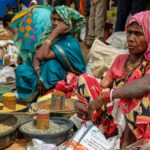Adivasi Divas is a regional public holiday observed every year on August 9. It coincides with the International Day of the World’s Indigenous Peoples, declared by the United Nations in 1993. ‘Adivasi’ refers to various tribes living in the Indian subcontinent, while ‘Divas’ means ‘day’ in Hindi. Despite several advancements in modern society, indigenous people are often among the poorest ethnic groups. Adivasi Divas seeks to recognize the challenges these people continue to face today, as well as honor their perseverance and struggle for improvement. Around 104 million people (over 9% of India’s population) fall into this category.
History of Adivasi Divas
The Adivasi are the indigenous tribes of the Indian subcontinent. People from these tribes live as foragers or as tribalistic sedentary communities, primarily in India. The term also refers to ethnic minorities in the neighboring countries of Bangladesh, Nepal, and Sri Lanka. But India does not recognize tribes as indigenous people.These tribes are considered to be the original inhabitants of India, before the Dravidian and Indo-Aryan people. However, many present-day Adivasi communities were formed after the decline of the Indus Valley Civilization. Although the Adivasis are considered socially and economically backward, they often enjoyed autonomy and evolved mixed hunter-gatherer and farming economies in ancient and medieval India. In some areas, securing Adivasi approval and support was considered important by local rulers.Larger Adivasi groups sustained their kingdoms in central India. The Meenas and Gond Rajas of Garha-Mandla and Chanda formed a kind of Adivasi aristocracy. These relations soured during the Mughal rule in India, where many of them were killed in wars between the two tribes.Under British rule, the colonial administration also encroached upon the tribal system, leading to the tribes resenting and rebelling against the British. Rising feudalism in India under British rule also worsened their relations and contributed to the social and economic devolution of the tribes. Forest, as well as farmland belonging to the tribes, was taken by the British who instead of helping the communities, imposed taxes on them. When the tribes were unable to pay, they were coerced into bonded labor.On being exposed to common infectious diseases from Eurasia, the isolated tribes of the South Andaman Island were badly affected and experienced a huge population decline in 1789.
Adivasi Divas timeline
Adivasi tribes are pushed into the hills after the Indo-Aryan tribes invade their land.
The British colonization worsens India’s economic standing.
Under the newly written Indian constitution, the Adivasis are provided with special protective provisions.
The Forest Rights Act is legislated to secure the land and forest rights of the tribes.
Adivasi Divas FAQs
Where do Adivasi people live?
Most of them live in the northeastern Indian states of Arunachal Pradesh, Mizoram, and Nagaland. Some also live in the hills and forests of central and southern India, and the Andaman and Nicobar Islands.
Why are Adivasis forced to leave their land?
They have been forced to leave their land because of increasing marginalization along with economic and ecological changes. They are also forced to leave their homes and move to urban areas for better work opportunities.
What does the term ‘Adivasi’ mean?
While the term refers to indigenous people, it can be broken down to ‘adi’ — earliest time — and ‘vasi’ — a resident of.
How to Observe Adivasi Divas
-
Appreciate Adivasi art
Appreciate the plethora of art forms created and sustained by the Adivasis community. These art forms include Warli, Madhubani, Bhil, and Gond art.
-
Raise awareness
Raise awareness about the tribal communities. You can do this by learning more about them, sharing information with your friends and family, and posting about the issues on social media.
-
Read Adivasi literature
Read some of the enlightening works of literature produced by the Adivasi communities and sustained through oral traditions. This will give you a better idea about their lives and history.
5 Facts You May Not Have Known About The Adivasi
-
Fight prejudice
Despite several protected provisions, the Adivasi community still faces a lot of prejudice from mainstream India.
-
Poor literacy
Many Adivasi children drop out of school early and are unable to continue with their education because of a lack of funds.
-
Social and economic hardship
At the national level, it has been estimated that nearly half of the Adivasi people live below the poverty line.
-
Dispossession and displacement
Even to this day, many communities are losing their homes to economic ambitions like mining, dam building, and other large-scale development projects.
-
Uncontacted tribe
There are only a handful of uncontacted tribes in the world where the government of India has prohibited travel within three nautical miles of the island.
Why Adivasi Divas is Important
-
Art and culture
The Adivasi communities possess an invaluable treasure trove of traditions, culture, and heritage that is hard to ignore. It is important to preserve this, which cannot be done without educating ourselves more about the people who have made it.
-
Experts in nature conservation
The Adivasis have made tremendous contributions to the diverse culture of the Indian subcontinent. They are also experts in wildlife and nature conservation, along with sustainable agricultural practices.
-
Everyone deserves to live with respect
The Adivasis have long been marginalized, and despite government help, many of them do not have the resources to break out of poverty. It is important to raise awareness about them if we want to create a more equitable world.
Adivasi Divas dates
| Year | Date | Day |
|---|---|---|
| 2023 | August 9 | Wednesday |
| 2024 | August 9 | Friday |
| 2025 | August 9 | Saturday |
| 2026 | August 9 | Sunday |
| 2027 | August 9 | Monday |





















